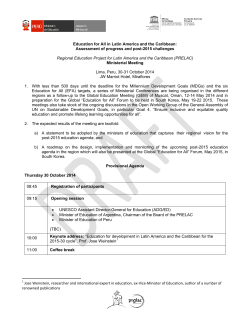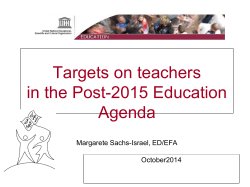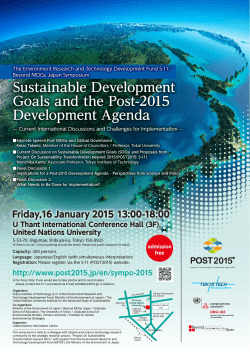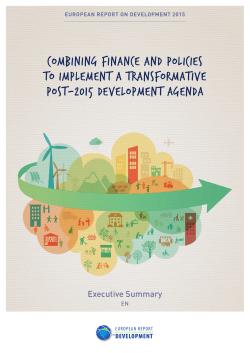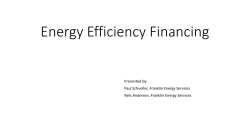
Terms of Reference Education Post-2015
Terms of Reference Study on how to scale up EU Impact on Education Post-2015 1. BACKGROUND INFORMATION .................................................................................. 2 2. OBJECTIVE, PURPOSE & EXPECTED RESULTS...............................................................7 3. ASSUMPTIONS & RISKS .................................................................................... ……...8 4. SCOPE OF THE WORK................................................................................................. 8 5. LOGISTICS AND TIMING ........................................................................................... 10 6. REQUIREMENTS ....................................................................................................... 10 7. REPORTS ................................................................................................................ ..11 8. MONITORING AND EVALUATION ............................................................................. 11 Page 1 1. BACKGROUND INFORMATION 1.1. Context of the Contract In January 2013 with the support of the EC, Alliance20151 launched a new three-year advocacy programme. Its overall objective is to enhance coordination and dialogue between Alliance2015 members, beneficiaries and partners, and the institutions of the European Union. Its specific objective is to build a structured dialogue between Alliance2015 members, beneficiaries and Southern partners, and the relevant EU institutions contributing towards the achievement of the Millennium Development Goals (MDGs). As part of the larger project two studies on Education and Food & Nutrition Security (F&NS), respectively, will be conducted in the second half of 2013 (education) and 2014 (F&NS). Each of the studies will be followed by roundtables in Copenhagen and Dublin. These Terms of Reference relate to the study on education. More detailed information about the Alliance2015 and the Alliance2015 Initiative on Structured Dialogue with the EU can be found on the Alliance2015 website.2 1.2. The current situation in the sector Education was first included as a key component in development aid in early 1960s with purpose of developing a strong workforce and a focus on meeting manpower needs through vocational training and development of work skills. In the 1980s education aid was broadened to include primary and secondary education; and the humanities and social science. The shift was spurred by findings from World Bank studies on education outcomes showing that primary education had the highest economic returns. The 1990s were dominated by the Education for All (EFA) framework and its six specific educational goals launched at the World Education Forum in Dakar in 1990. The six goals target the whole educational cycle3. In 2000, a decade later, and after slow progress on EFA, the international community adopted the eight MDGs at the UN summit in New York. Although the commitment to supporting EFA was reaffirmed education the goals related to education in the MDGs had a strong focus on universal primary education and gender parity, in MDGs 2 and 3, respectively4. 1 Alliance2015 is a strategic network of seven European non-government organizations engaged in humanitarian and development activities. The Alliance2015 members are Cesvi from Italy, Concern Worldwide from Ireland, Welthungerhilfe from Germany, Hivos from the Netherlands, IBIS from Denmark, People in Need from the Czech Republic and ACTED from France. 2 3 4 Available at: http://www.alliance2015.org/index.php?id=66 The six specific education goals: Expand and improve comprehensive early childhood care and education, especially for the most vulnerable and disadvantaged children. Ensure that by 2015 all children, particularly girls, those in difficult circumstances, and those belonging to ethnic minorities, have access to and complete, free, and compulsory primary education of good quality. Ensure that the learning needs of all young people and adults are met through equitable access to appropriate learning and life-skills programs. Achieve a 50 % improvement in adult literacy by 2015, especially for women, and equitable access to basic and continuing education for all adults. Eliminate gender disparities in primary and secondary education by 2005, and achieve gender equality in education by 2015, with a focus on ensuring girls' full and equal access to and achievement in basic education of good quality. Improve all aspects of the quality of education and ensure the excellence of all so that recognized and measurable learning outcomes are achieved by all, especially in literacy, numeracy and essential life skills. The two MDGs related to education: Page 2 Although good progress was made in the first decade of the 2000s, especially with regard to enrolment rates and girls’ access to education, the narrowing down of the EFA framework to focus on universal primary education in MDG 2 and gender disparities in education in MDG 3 has also shown to have significant detrimental consequences for the education sector as, a whole. With less than two years left to the deadline for achieving the goal on education (MDG 2) it has become clear that progress has been too slow and uneven. There are still 131 million children out of school of whom the majority are living in sub-Saharan Africa, millions more are simply sitting in a classroom with an untrained teacher, leaving school barely able to read or write. In 2012 the Global Campaign for Education (GCE) estimated that about 1.7 million new teachers are needed to achieve universal primary education and more than 5 million more are needed to account for those who leave or retire5. There are 755 million non-literate adults. Progress towards universal enrolment has slowed and if the current trend continues there will be more children out of school by 2015 than there are today. In some countries universal primary enrolment has lost momentum as a political priority precisely because of the success so far and the perceived need to shift focus and resources to other educational levels (ODI, 2012). Generally, however, the focus on universal primary education, has led to unforeseen neglect of other important issues and educational levels, such early childhood education, post-primary education, quality learning outcomes and equitable access. Furthermore, the strong emphasis on access and enrolment in primary education has meant that key elements of good quality education, including adequate number of well-trained teachers, adequate infrastructure and sufficient financing have been ignored. The latter issue is a huge problem. The gap between the financing currently provided and what is needed to secure equitable, quality education at primary and secondary level is huge. $26 billion in additional funding is needed to achieve universal primary school and $38 billion to achieve universal lower secondary school, both of which are targets included in the proposed goals for 2015 (GMR Policy brief 06, 2013). After having expanded during the period from the 1960s to late 1980s education aid has slowed down in the 1990s (ReCom/WIDER, 2013/018). Support to basic education covering primary education, basic life skills for youth and adults, and early childhood education6 is dropping and many donors have reduced their support to education and others plan to do so. According to the 2013 Education Watch Report by GCE less than $US 13.5 billion of the global education budget is going to basic education and only a fraction of that is supporting low-income countries most in need. About half of the 61 million primary-school aged out-of-school children live in situations of crisis and/or natural hazard. With 2015 drawing nearer, the Post-2015 discussions are gathering pace and governments and the wider international community are working to define the new development framework that can build on the experiences and lessons learnt with the MDGs and address the challenges of the world of today and tomorrow. With regard to education there is a general agreement that the education agenda should be widened. This was confirmed in the Global Thematic Consultation on Education in Goal 2: Ensure that, by 2015, children everywhere, boys and girls alike, will be able to complete a full course of primary schooling; Goal 3: Eliminate gender disparity in primary and secondary education, preferably by 2005, and in all levels of education no later than 2015. 5 Every Child Needs a Teacher: Closing the Trained Teacher Gap Global Campaign for Education and Education International 2012) 6 OECD’s definition of what constitutes basic education is applied here. Page 3 the post-2015 Development Agenda meeting in Dakar, 18-19 March 2013. The latter meeting also came up with a proposed goal for the post-2015 period: “Equitable quality lifelong education and learning for all”. The report of the UN High Level Panel, which was released in June 2013, reaffirmed the need for a wider agenda and more ambitious goal-setting for the Post-2015 period and proposed ‘quality and lifelong learning’ as the overarching post-2015 education goal. The Alliance2015 members have taken an active part in a number of the meetings and regional and global thematic consultations of relevance to education, primarily through Beyond2015, the regional EU consultation in August 2012 and the thematic consultation in relation to (i) Food Security and Nutrition (ii) Education (iii) Conflict, Disasters & Fragility and, (iv) Inequalities. Alliance2015 has in a letter to Open Working Group on sustainable development highlighted three priority areas in education where action is needed in order to ensure the availability of a human capital, which can contribute to, and benefit from realizing economic growth and improved livelihoods. They are: equitable access, quality and financing7. Equitable access Access to education must be life-long and universal in order to ensure equity. There is need to include the full EFA agenda and expand access from enrolment in primary school to the full cycle of education. Access to education must be focused on those who are hardest to reach and there is need to address the multiple forms of exclusion, inequalities and discrimination that are based on ethnicity, gender, age, social class, language, national or social origin, disability and other status or identity criteria. There is need to ensure that the right to quality education is realized in emergency contexts and in disaster-prone areas recognizing that about half of the 61 million primary-school aged children (i.e. 42% of total out-of-school children (GMR 2011) lives in situations of crisis and/or natural hazards, recognizing also the particular vulnerability of girls. Measurement of equitable access must be broader than enrolment and include strong and clear goals and targets. The collection of disaggregated data is needed to measure progress in relation to different groups. A recent review of the debates on the Post-2015 education MDGs carried out as part of a larger study8 shows that there is consensus about the need to address inequalities, particularly within countries and in relation to fragile states. At the European level the EU High Level Conference on Education and Development held in Brussels 23 May 2013 the EC confirmed EU’s and its member countries’ commitment to advocate for education and strengthened support to partner countries, in particular to fragile states and countries which are off-track in terms of reaching international education goals. Other commitments included seeking to ensure that by 2030 every child completes at least basic education and has basic literacy and numeracy skills, and a promise to monitor progress and impact on the ground. In his closing speech at the High Level Conference on Education and Development, EU Development Commissioner, Andris Piebalg, emphasized that equitable access to quality education will continue and play an important role in future discussions EU intend to have on development goals, country support and 7 8 Alliance2015 priorities on education to the open working group (Letter to OWG, Alliance2015, August 2013) ODI, 2012 Page 4 resource allocation. There is definitely a need to accelerate the EU’s efforts. A special report on EU support to basic education in SSA and South Asia shows that only modest progress was achieved for the goal of ensuring primary education for all children, although better for enrolment than for completion9. With regard to eliminating gender disparities in education some progress had been made but the findings of the study also revealed significant persisting inequalities in regional and social groups. Alliance2015 partners have knowledge and experience from working with education for marginalised groups and in conflict areas. In the coming two years there is opportunity for A2015 to add value to and impact on the post 2015 agenda on emerging issues in the conflict and fragility field through enhanced vision and intervention, e.g. on the role of education in bridging the ‘humanitarian and development divide’. There is opportunity and need to emphasize and bring to the attention of donors and governments that not only children but also youth and adults must have access to basic education. Quality education The dual challenge of improving quality and expanding access to education in an equitable way has not been met. The explanations for this are many, including the strong focus on access in the MDGs, which has overshadowed the issue of quality, lack of political will and insufficient financing. Quality is key in the EFA framework as it determines how much and how well students learn and the extent to which their education achieves a range of personal, social and development goals Quality education must include at least literacy and numeracy, but also acquisition of capabilities, knowledge, values and skills which improve nutrition and health; and provides the opportunities for meaningful life skills, citizenship, livelihood choices and not least the ability to participate in the development of the society. In addition to shifting from the current emphasis on enrolment and completion to learning a new set of indicators that allow us to address and monitor quality and learning once the new goals are set is needed. There is need to close the ‘trained teachers gap’ and invest in their recruitment, terms of employment, training, teaching methods and teaching materials. Other elements of quality education that should be given attention are lack of good governance, which is closely linked to lack of political will to invest in education and implement policy reforms, school environment, training materials and, parents and communities involvement in the formulation and implementation of education policies and plans. The learning crisis calls for urgent action –250 million children are not leaning the basics, some because they don’t make it to grade 4 and others because they are in school but hardly learning (GMR, 2012). It is urgent to act. The Learning Metrics Task Force (The World We Want, Sept. 2013) advocates for a holistic learning framework that extends beyond literacy and numeracy to encompass other factors, e.g. physical, social and emotional wellbeing, learning approaches, cognition, technology and science,. . In addition, to enable comparisons at international level, there is need to define global targets and indicators that allow us to assess learning outcomes. The work on developing such indicators has started, e.g. service delivery Indicators in Education and Health 9 European Court of Auditors, Special Report no.12, 2010 Page 5 (WB/African Development Fund and African Economic Research Consortium, 2013) but needs further elaboration. The priorities of EU in education as outlined in the EU Policy for Development: Increasing the Impact of EU Development Policy: an Agenda for Change10 reaffirm the promise to support quality education as part of the support for human development and social inclusion. This is backed up by findings from independent evaluation reports of EU’s support to basic education showing that for the priority goal, improving education quality, few of the intended improvements were achieved11. In the EC Communication: A Decent Life for All: Ending poverty and giving the world a sustainable future12 it is also recognized that in order for education to realize its transformational power and potential as a key player in eradication of hunger and improving food security, health and well-being, there is need to deliver on the unfinished business of the current MDG agenda, but also to move beyond the present framework and shift from purely quantitative goals to address quality and inequalities. However, to date these statements and communications have not been followed up by any action plan, including concrete goals and targets and is an obvious area for civil society advocacy. There are good opportunities and a favourable political environment for Alliance2015 to add value to these discussions. The Alliance has deep knowledge and experiences from the field of what constitutes good quality education from implementing concrete education programs in a number of African countries working with quality in relation to pedagogy, language, teaching methods and other important aspects of quality related to education. Education financing Substantial and continuous economic financing together with effective and rights-based national and international policies is crucial in addressing the challenges in quality education. There is need to increase financing for education Governments should endorse the international recommended benchmark for domestic spending on education at 20% allocation - and ensure that at least 50% of education budgets are allocated to basic education - which would amount to 10% of the overall government budget being spent on basic education13. International donors should match the investment of partner countries with the same target, which would amount to 10% of their ODA budgets being committed to basic education Funds to education must be spent transparently and accountably on agreed priorities Donors should reallocate aid spent on scholarships and imputed costs to secure that it reaches developing countries and those who are most in need Global spending on military should be re-allocated to contribute to closing the annual EFA financing gap 10 http://ec.europe.eu/europeaid/what/development-policies/documents/agenda_for_change_en.pdf 11 EU (2012) and Alliance2015( 2006) 12 http://ec.europe.eu/europeaid/documents/2013.02-22_communication_a_decent_life_for_all_post_2015_en.pdf 13 The European Commission has been advised by the European Parliament to spend at least 20% of their development budget to health and education, but is in practice only reaching 10% (OECD-DAC figures) Page 6 Governments need to be more concerned about sub-sector allocations within education budgets and there is need to ensure that equity issues are addressed, e.g. through disaggregated and transparent public budget and spending figures Civil society and citizens should be given a genuine role in decision-making and monitoring of spending on education enabling them to hold their Government accountable and provide them with education as an essential service Governments in poor countries could raise more money for education by broadening their tax base, e.g. reducing the prevalence of tax avoidance and complement existing financing sources with income from taxation of extraction of natural resources Against this background the Alliance2015 will need a consultant to conduct a study on how to scale up EU Impact on Education Post-2015 as follows: 2. OBJECTIVE, PURPOSE & EXPECTED RESULTS OF THE STUDY 2.1. The overall objective The overall objective of the project (the Action) of which this contract will be a part is as follows: To enhance coordination and dialogue between Alliance2015 members, beneficiaries and partners, and the institutions of the European Union. The overall goal of this study will be as follows: to contribute to the discussion on the development in the EU’s aid to education and the structured dialogue between Alliance2015 members, beneficiaries and partners and, the institutions of the European Union, about the achievement of the MDGs and the framing of the post-2015 agenda on education. 2.2. The purpose The purpose(s) of this contract] is/are as follows: The first is to capture recent trends and changes in the size and focus of the EU’s aid to education and its financing modalities with a view to assessing their relevance for achieving MDG 2 and for addressing current education challenges The second is to provide an overview and assessment of the EU’s and major international donor organisations’ aid policies and strategies on education focusing on qualitative priorities and how these are implemented. In particular focusing on how priority is given to the following key focal areas: Equitable access and participation Quality education for effective learning Inclusion of citizens’ (as parents) access to information and in the design and monitoring of education policy. 2.3. Results to be achieved by the Contractor Develop an analysis of the size and focus of EU27+EC’s support to MDG2, of key policies and strategies designed to address issues of equitable access, quality and learning as well as issues of governance pertaining to education. Page 7 Suggest substantiated recommendations to help address the key identified issues. 3. ASSUMPTIONS & RISKS 3.1. Assumptions underlying the project The assumptions for the overall project of which this study is a part are outlined in: Europe Aid/131142/C/ACT/TPS – Annex A – Grant application form, p.26 -27. 3.2. Risks Of particular relevance to this study is the following risk: That the statistics required across EU27+EC are not available in a way which enables clear analysis. 4. SCOPE OF THE WORK 4.1. General The study will provide an Alliance2015 ‘lens’ on the issue of education adding value to advocacy at national, EU and partner country levels. It will take stock of current trends and tangible plans for future initiatives. However, in order to provide a constructive and informed input to the dialogue with the European Union on the priorities and actions within the area of education and development, we need to update our existing knowledge about the key challenges and opportunities in EU’s policies and financing mechanisms and their implications for the Post-2015 agenda on education. The study will be based on and complement and follow up on relevant findings in previous studies of the quantitative and qualitative aspects of EU’s support to education, including the study carried out by Alliance2015 in 2006 (Watch report 3, 2006) and other studies. The findings of the study will feed into an international conference on education and development organised by the Alliance2015 in Copenhagen in April 2014. Relevant Alliance 22015 background documents will be provided by Concern Worldwide and IBIS. 4.2. Specific work Develop a pragmatic methodology, an outline of which is to be included with the tender. The methodology must include a definition of the issues to be addressed and the way they are to be measured and prioritized and proposed methodology sources. The study will be carried out as desk-based research and through targeted interviews with key stakeholders and resource persons within the area of education and development at national and regional levels (Europe and Africa). The desk research will include a review of recent literature of relevance to providing information on EU support to education in developing countries and how to scaling up EU Impact on Education Post-2015. The analysis work should concentrate on information available on-line from EU’s own sources and related documents and websites deemed useful and possible within the limited scope of the study. The data acquisition analysis will consist of the following tasks: In relation to purposes/results 1 and 2 (described in section 2.2.): Page 8 – – – – – – – – Review and analyse the relevant literature and statistics on the size and focus of EU support to education in developing countries (proposed 2010 to 2013) with a view to identifying trends and key factors in relation to promoting and/or reducing EU’s impact on Education Post-2015 - focusing on the activities of the EC Commission and selected member states Assess the financing modalities, including multi-donor frameworks as well as bilateral relations with developing countries, focusing on the activities of the EC Commission and selected member states Review the outcomes and future directions of current and recent regional and global policies and debates of relevance to MDG 2 and the education agenda post-2015 Review current strategies and policies applied by the EU’s in its support to education in relation to relevant international aid policies and structures, particular focus should be put on assessing the extent to which and how the EU has influenced these policies and structures, particularly with regard to the EU’s and its member states’ role as an active player in the Global Partnership on Education (GPE). What are the priorities and policies? How are they being pursued? Assess whether the EU policy on education is based on partner countries’ needs, capacities, commitments and performance? Possible implications of redirecting and/or out-phasing of bilateral donors’ support in education in terms financial gaps, monitoring etc.? What does EU do to ensure the continued coordination of financing of education and the sustainability and ownership of results gained through previous and on-going support? Identify and analyse the quality aspects (language, teacher training, pedagogy, training materials, learning outcomes etc.) in the EU’s support to education and the demands those quality aspects put on EU in terms of national education authorities, capacity of the EU country offices and division of labour among donors Identify and analyse the equity aspects in the support of EU to education focusing on marginalised groups. Articulate key recommendations to address the main problems analysed. Schedule of tasks and deliverables Task Time The Consultant prepares an Inception Report including a detailed work plan, methodology etc. Analysis work has started. By mid month 1 1st Meeting with IBIS/round of comments Draft report submitted to the Steering Committee By beginning of month 3 2nd Meeting with IBIS/round of comments Final report submitted to IBIS By the end of month 3 4.3. Project management 4.3.1. Responsible body Page 9 Concern Worldwide/Olive Towey is lead organization for the overall project of which this study is a part. IBIS, partner in the project, is responsible for managing the study. 4.3.2. Management structure The consultant will report to Anne Sørensen (ams@ibis.dk) in the Department for Policy and Campaigns in IBIS Copenhagen. In collaboration with the Education experts of the Alliance2015, IBIS’ role will be to: provide input to the Consultant help ensure the quality of the study by reacting to work plans, methodology, initial findings help ensure that the outputs of the study will provide useful the process of developing a structured dialogue with EU and to the planned international Conference on education 5. LOGISTICS AND TIMING 5.2. Start date & Period of implementation of tasks The intended start date is end of October 2013 and the period of implementation of the contract will be three months from the starting date. 6. REQUIREMENTS Key expert /consultant Qualifications and skills 1. Post Graduate Degree or equivalent in Economics, Social Sciences or related disciplines, and/or with least 5 to 10 years relevant work experience 2. Basic computer skills (word processing and statistical data analysis) and demonstrated ability to analyze data using SPSS/E-VIEWS/STATA statistical and computer packages. 3. Ability to work independently with strong sense of initiative, discipline and self-motivation. 4. Demonstrated ability to speak and write professionally in English Professional experience 1. Experience with research related studies and consultative work in the development aid /Education sector 2. Experience of liaising with Government organizations and NGOs 5. Strong knowledge of global and EU policies relating to education in developing countries Page 10 7. REPORTS 7.1. Reporting requirements The Contractor will submit the following reports in English in electronic format (word): Inception Report of maximum 12 pages to be produced after two weeks from the start of implementation. In the report the Contractor shall describe e.g. methodology, work plan, initial findings, progress in collecting data, any difficulties encountered or expected in addition to the work. The Contractor should proceed with his/her work unless the Contracting Authority sends comments on the inception report. Draft final report of maximum 30 pages (main text, excluding annexes) in the format given below. This report shall be submitted no later than one month before the end of the period of implementation of tasks. Final report with the same specifications as the draft final report, incorporating any comments received from the parties on the draft report. The deadline for sending the final report is 7 days after receipt of comments on the draft final report. The detailed analyses underpinning the recommendations will be presented in annexes to the main report. The final report must be provided along with the corresponding invoice. It is essential that the report be clear, unambiguous and comprehensible for the non-specialist. The report of the study will serve as information for the broader public, including public institutions as well as civil society organizations. To this end, the report should be edited as a publishable document. The Draft Report and the Final Report should be presented in English with the following format: Title page Table of Contents Executive Summary Introduction Detailed description of the methodology Findings, in accordance with the structure indicated by the methodology Conclusions including any common critical success factors Annexes 7.2. Submission and approval of reports The report referred to above must be submitted to IBIS, att. Anne Sørensen. IBIS is responsible for approving the reports. 8. MONITORING AND EVALUATION 8.1. Definition of indicators The performance measures pertain to those of the overall project of which this study is a part. Page 11
© Copyright 2025
